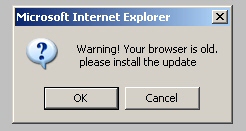 When you see an online order form that bears Microsoft’s logo and the words “pay to: Microsoft Inc.,” are you any more likely to enter a credit card number into the form and click submit? That’s the psychological experiment currently being undertaken by a company that calls itself DefenceLab, which subjects unsuspecting users to its peculiar blend of fakealert with rogue antivirus.
When you see an online order form that bears Microsoft’s logo and the words “pay to: Microsoft Inc.,” are you any more likely to enter a credit card number into the form and click submit? That’s the psychological experiment currently being undertaken by a company that calls itself DefenceLab, which subjects unsuspecting users to its peculiar blend of fakealert with rogue antivirus.
Last year, our friends at Sunbelt wrote two very interesting blog items about DefenceLab. At the time, DefenceLab was accused of lifting content from the products and Web sites of legitimate comapnies such as Microsoft and AVG, inserting that text into their own Web site. They had stolen AVG‘s “awards” links from that company’s Web site, and posted it on their own; They were also lifting, whole cloth, copy from Microsoft’s Web site, then replacing words in the pages (like “Microsoft”) with “DefenceLab.”
Well these slugs are at it again, only this time they’ve dragged a US-based electronic payment processor into their scam. The payment processor handles the credit card transactions from victims who fall prey to the scam’s fake alert message about a nonexistent infection. Most rogues use fly-by-night processors, based overseas, who provide scant contact information, and never respond to requests for a refund. DefenceLab, however, provides would-be snake oil purchasers with both an email address and toll-free telephone number, in case of a transaction problem.
The only problem I can imagine would be if anyone actually paid perfectly good money to buy their bogus app.
The DefenceLab rogue also uses some time-honored techniques to trap victims, essentially locking nontechnical users out of their computer. Click through to the next page to see exactly how they do it; I’ll even throw in, free of charge, a simple trick that will let you prevent the program from popping up fake antivirus alerts.
















































































